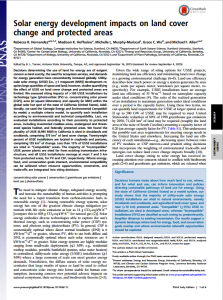Full Title: Solar Energy Development Impacts on Land Cover Change and Protected Areas
Author(s): Rebecca R. Hernandeza, Madison K. Hoffacker, Michelle L. Murphy-Mariscal, Grace C. Wu, and Michael F. Allen
Publisher(s): Proceedings of the National Academy of Science (PNAS)
Publication Date: September 1, 2015
Full Text: Download Resource
Description (excerpt):
Decisions determining the use of land for energy are of exigent concern as land scarcity, the need for ecosystem services, and demands for energy generation have concomitantly increased globally. Utility-scale solar energy (USSE) [i.e., ≥1 megawatt (MW)] development requires large quantities of space and land; however, studies quantifying the effect of USSE on land cover change and protected areas are limited. We assessed siting impacts of >160 USSE installations by technology type [photovoltaic (PV) vs. concentrating solar power (CSP)], area (in square kilometers), and capacity (in MW) within the global solar hot spot of the state of California (United States). Additionally, we used the Carnegie Energy and Environmental Compatibility model, a multiple criteria model, to quantify each installation according to environmental and technical compatibility. Last, we evaluated installations according to their proximity to protected areas, including inventoried roadless areas, endangered and threatened species habitat, and federally protected areas. We found the plurality of USSE (6,995 MW) in California is sited in shrublands and scrublands, comprising 375 km2 of land cover change. Twenty-eight percent of USSE installations are located in croplands and pastures, comprising 155 km2 of change. Less than 15% of USSE installations are sited in “Compatible” areas. The majority of “Incompatible” USSE power plants are sited far from existing transmission infrastructure, and all USSE installations average at most 7 and 5 km from protected areas, for PV and CSP, respectively. Where energy, food, and conservation goals intersect, environmental compatibility can be achieved when resource opportunities, constraints, and trade-offs are integrated into siting decisions.
